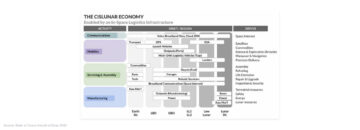Super apps are increasingly being mentioned in the news — usually in the context of what Microsoft, Meta, Twitter, and other large technology companies are working to build next. But even in the technology industry, many builders and operators have little sense of what a super app actually is, or what it’s capable of doing. The answer: basically everything.
In brief, a super app is an application that builds upon its core functionality to mix and mash a bunch of seemingly unrelated services — but ones the user would need or want to do anyway — into one place. Imagine a single app that allows you to shop for groceries, pay your rent, review work documents, refill prescriptions, book a trip, and chat with friends, interest groups, and businesses — that’s a super app. Sounds more like your entire iPhone than one app, right? That’s because it essentially is. True super apps are more akin to an operating system than any Western app, with the bonus ability to share fun selfies with your friends.
TABLE OF CONTENTS
TABLE OF CONTENTS
History of the Super App
The poster child for super apps has long been China’s omnibus app WeChat. Launched by Tencent in 2011, WeChat allows its users to text each other, access city services, pay for your utilities, send peer-to-peer payments, stream videos… the list is practically endless. Another popular super app is Go-Jek in Indonesia, which combines a ride-hailing app with additional services like paying utility bills, moving and shipping, pharmacy delivery, all in one spot (its app description is literally “One app for every need”).
The secret to a super app’s success is its ability to use existing user traffic and distribution (in WeChat’s case, the flywheel started with messaging) to drive lead generation and traffic to its partners. The more you can do on the app — with as little friction as possible — the stronger the flywheel.
Super apps also aren’t possible without ample user trust. This is because in order to be successful, super apps need to aggregate a great deal of user data, so their parent companies must be incredibly thoughtful about what data they share (or more importantly don’t share) with their partner networks. They must also be sensitive to user control. With WeChat, for example, if you want to prevent a business you’ve engaged with from contacting you again, one swipe is all it takes. However, once this trust with the user is established, it paves the way for payments, one of the most important and foundational components of super apps. Looking to WeChat again, this equates to hundreds of billions of dollars in transaction volume AND users keeping balances on the app, making micro-transactions frictionless and economical.
TABLE OF CONTENTS
TABLE OF CONTENTS
Super Apps in the U.S.?
Given this definition, there is no true super app in the West yet. But we can see many examples of apps that are headed in the right direction. Food delivery giant DoorDash, for example, announced last month it would start selling and delivering cosmetics from online beauty retailer Sephora in less than an hour, on average, while letting Sephora VIB members continue to accrue points for their purchases — even while in the DoorDash app. Uber, of course, famously spun off its Ubereats business only to later add it back into the main app, and Amazon now pushes suggestions for related services like music lessons when the customer searches for products like microphones.
All of these developments show a mindset shift (finally!) happening in the West. Historically, Western companies have thought about growth horizontally: they want to launch a hit product and then grow the product’s number of users across the world. This is reflected in our obsessive focus on metrics like monthly subscriber growth and daily active users. Eastern companies, on the other hand, have long thought about growth vertically: after they launch a successful feature, they then focus on how else they can help their existing customers. Success is measured more in terms of visits per day (i.e., how many tasks they’ve helped their customer tick off a list), versus simply total active users.
Once you’re focused on solving as many customer problems as possible, you also open yourself up to new revenue streams. To illustrate this, imagine a typical Western dating app. This app might have a high number of daily active users and strong engagement, but a limited path to monetization outside of standard monthly subscription fees. If you were to apply the super app mindset to the dating app experience, this company could grow vertically by integrating additional services that are relevant to people going on dates, such as being able to book restaurant reservations, hairdresser or salon appointments, or shared taxis. The dating app wouldn’t have to build everything themselves, they would just need to focus on building a strong core product and the payrails, and third-party partners would plug in for the rest. The dating app benefits from transaction fee, more user data, and retained mindshare, while the partner network benefits from the added distribution and business.
We can see a meditation app taking a similar approach. Users come for the mindfulness, but they can then also explore and book yoga retreats, buy candles and cozy bedding, and communicate with their doctor or favorite wellness communities. A super app mindset can be applied to any product roadmap brainstorm.
TABLE OF CONTENTS
TABLE OF CONTENTS
Challenges and Limitations
At this point, it’s hopefully clear why tech companies are bullish on super apps. Super apps help users be one click away from everything, with a single sign-on and payment information stored for easy transacting. This leads to increased app visits and time spent in-app, which fuels the flywheel for more services and revenue streams. Additionally, super apps make sense alongside the fact that consumers are less and less likely to download new apps these days. [Insert stat/source]
So, what will it take for the West to catch up?
First, leadership at the highest levels of a company that wants to build a super app needs to prioritize vertical over just horizontal growth. The reason you need executive buy-in is because switching to a super app model may negatively impact things like ad revenue in the short-term, as you give more screen time to partners than your core service — but it’s key to driving traffic to those partners so the flywheel spins. Second, Western companies may need to dramatically rethink their systems of identity and user control. If I’m going to use one app for everything, I want control over what information about me is shared as a part of 1:1 friend conversations versus interest groups versus brands. Third, teams must ruthlessly focus on building truly mobile-first experiences to take advantage of all the sensors and inputs our smartphones have to offer. This will help remove friction and reduce clutter for the user, especially as they are bouncing around services.
If you’re a startup building in this space or at a company trying to crack the super app code, please reach out! I’d love to learn more about what you’re building.
***
The views expressed here are those of the individual AH Capital Management, L.L.C. (“a16z”) personnel quoted and are not the views of a16z or its affiliates. Certain information contained in here has been obtained from third-party sources, including from portfolio companies of funds managed by a16z. While taken from sources believed to be reliable, a16z has not independently verified such information and makes no representations about the enduring accuracy of the information or its appropriateness for a given situation. In addition, this content may include third-party advertisements; a16z has not reviewed such advertisements and does not endorse any advertising content contained therein.
This content is provided for informational purposes only, and should not be relied upon as legal, business, investment, or tax advice. You should consult your own advisers as to those matters. References to any securities or digital assets are for illustrative purposes only, and do not constitute an investment recommendation or offer to provide investment advisory services. Furthermore, this content is not directed at nor intended for use by any investors or prospective investors, and may not under any circumstances be relied upon when making a decision to invest in any fund managed by a16z. (An offering to invest in an a16z fund will be made only by the private placement memorandum, subscription agreement, and other relevant documentation of any such fund and should be read in their entirety.) Any investments or portfolio companies mentioned, referred to, or described are not representative of all investments in vehicles managed by a16z, and there can be no assurance that the investments will be profitable or that other investments made in the future will have similar characteristics or results. A list of investments made by funds managed by Andreessen Horowitz (excluding investments for which the issuer has not provided permission for a16z to disclose publicly as well as unannounced investments in publicly traded digital assets) is available at https://a16z.com/investments/.
Charts and graphs provided within are for informational purposes solely and should not be relied upon when making any investment decision. Past performance is not indicative of future results. The content speaks only as of the date indicated. Any projections, estimates, forecasts, targets, prospects, and/or opinions expressed in these materials are subject to change without notice and may differ or be contrary to opinions expressed by others. Please see https://a16z.com/disclosures for additional important information.
- Andreessen Horowitz
- Bitcoin
- blockchain
- blockchain compliance
- blockchain conference
- coinbase
- coingenius
- Consensus
- consumer
- crypto conference
- crypto mining
- cryptocurrency
- decentralized
- DeFi
- Digital Assets
- ethereum
- machine learning
- non fungible token
- plato
- plato ai
- Plato Data Intelligence
- Platoblockchain
- PlatoData
- platogaming
- Polygon
- proof of stake
- super apps
- W3
- zephyrnet










